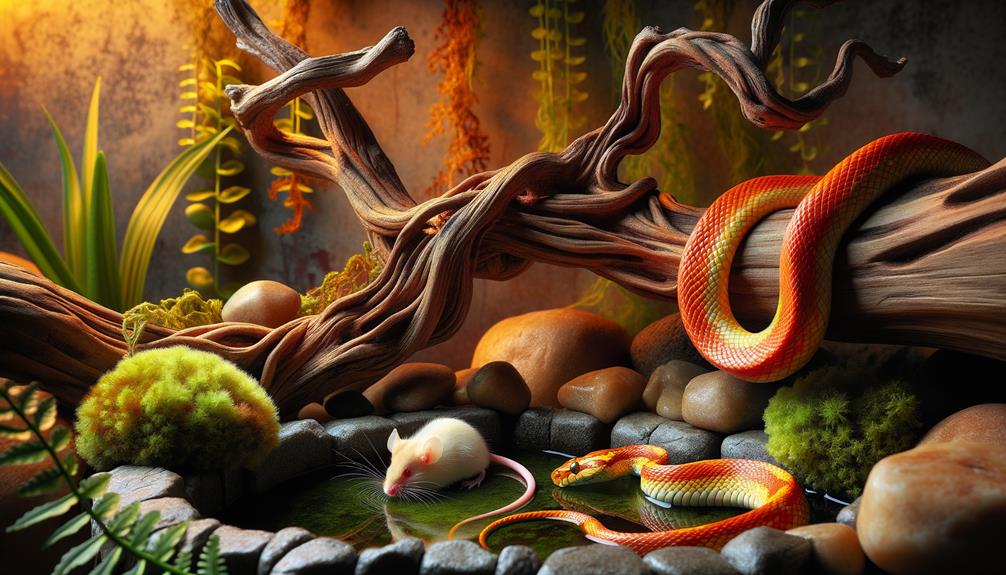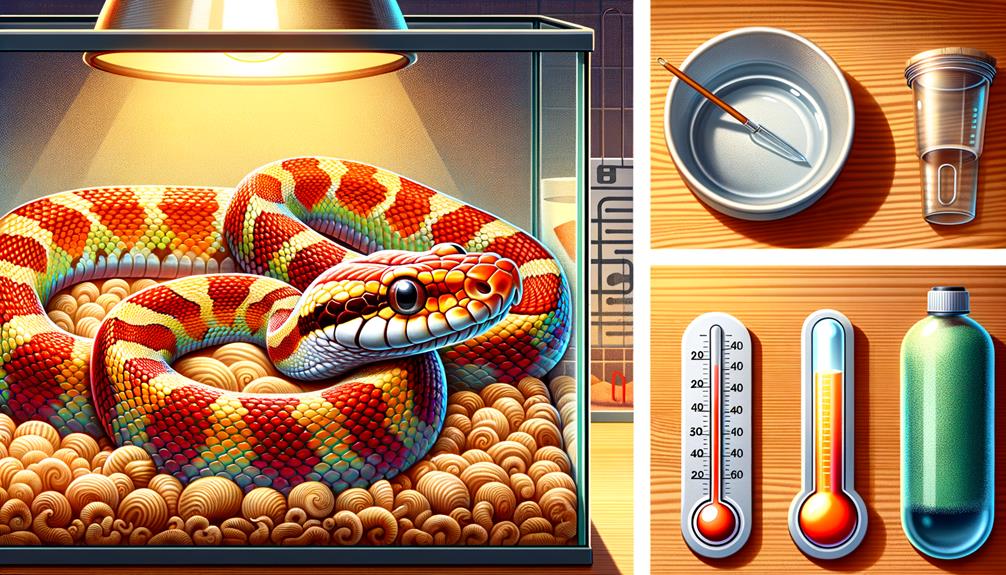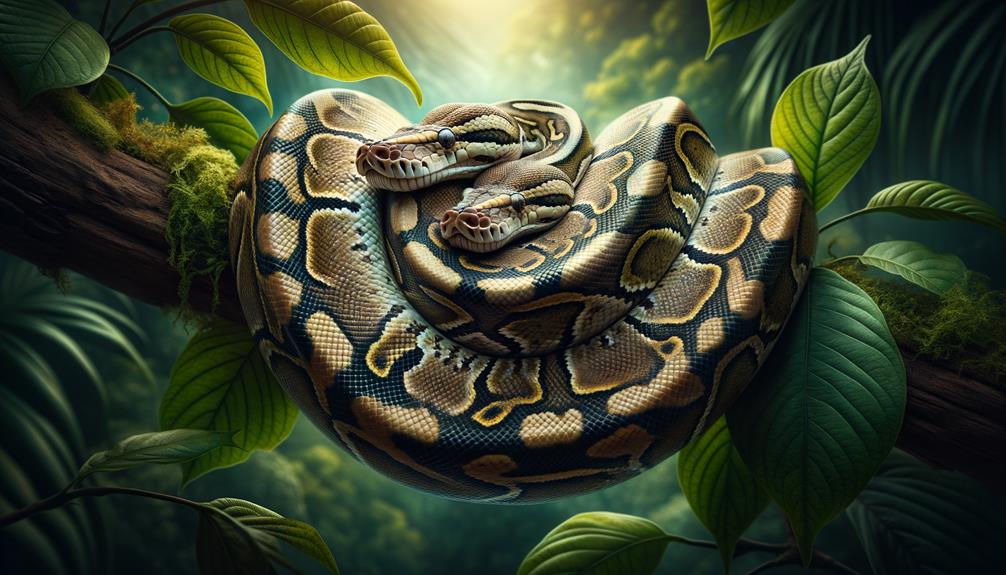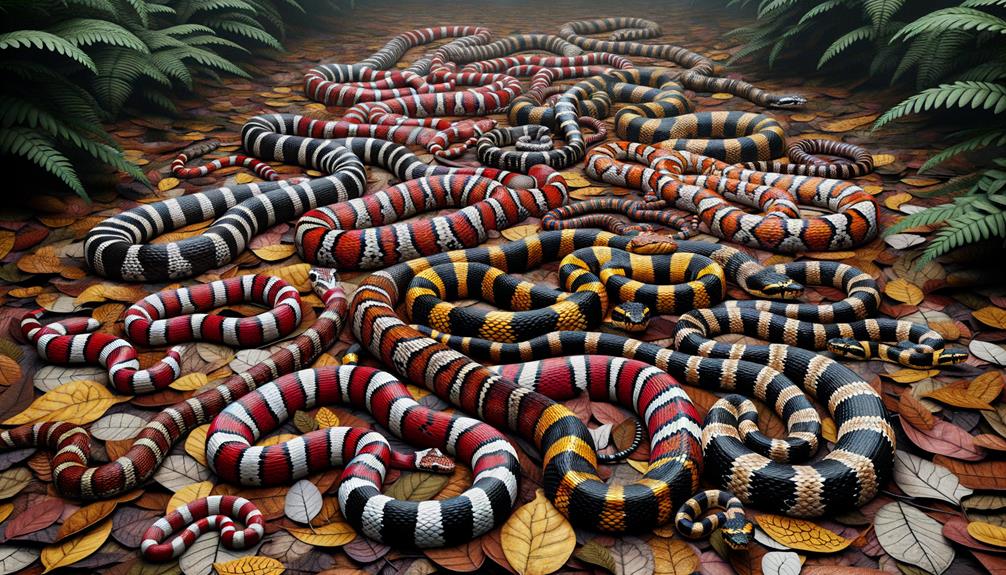Corn snakes make fantastic pets for beginners due to their calm nature and simple care. They rarely show aggression, making them a great choice for new reptile enthusiasts. To keep your pet happy and healthy, you'll need a 20-gallon tank with a secure lid, plenty of hiding spots, and a controlled environment with a temperature range of 80-85°F and humidity between 35-60%. Feed your snake frozen/thawed mice to ensure safety and health. Keep an eye out for common health issues like respiratory infections or mites. When choosing a corn snake, consider its temperament and health. By keeping these points in mind, you'll be well on your way to a rewarding experience with your new pet.
Key Takeaways
Corn snakes make ideal beginner pets due to their calm and gentle nature. They are not typically aggressive, making them safe and manageable pets. To house them properly, you'll need a minimum tank size of 20 gallons with secure lids. Feeding involves frozen/thawed mice, reducing the risk of injury from live prey. Regular monitoring and proper environmental conditions help prevent common health issues, such as respiratory infections and scale rot.
Corn Snake Temperament
Corn snakes are renowned for their exceptionally calm nature, making them an ideal choice for beginners and seasoned snake enthusiasts alike. Their gentle temperament is a significant reason why many novice reptile enthusiasts are drawn to them. In my experience, their behavior is remarkably calm, and they rarely exhibit aggressive tendencies. When threatened, they might display a defensive tail vibration, a harmless behavior that's more startling than dangerous.
Biting incidents with corn snakes are minimal, making them a great choice for those new to handling snakes. This is a huge relief for anyone worried about handling a snake for the first time. The ease of care associated with corn snakes makes them even more appealing. They don't demand a lot of special conditions, which means I can focus on simply enjoying their company.
Interacting with these snakes is usually a smooth process. With proper care and consistent handling, they become quite comfortable around their owners. I always feel a sense of freedom knowing I can safely interact with my corn snake without the constant worry of unpredictable behavior. Their docile temperament and willingness to engage make them ideal companions for anyone looking to explore the world of reptile ownership.
Housing Requirements

When setting up a habitat for a corn snake, it's crucial to provide a spacious environment that meets their specific needs. A minimum tank size of 20 gallons is recommended to ensure your pet has ample space to move around and grow.
Secure-fitting lids are a must to prevent escape attempts, as corn snakes are notorious for their Houdini-like skills. A well-planned habitat is vital for their health and happiness.
To create a stimulating environment, incorporate various hiding places and climbing branches that mimic their natural habitat. This will provide mental stimulation and exercise opportunities. Maintaining the right temperature range is critical, with an ambient temperature of 80-85°F and a basking spot of 85-88°F to facilitate effective thermoregulation.
A loose substrate like aspen shavings is ideal for burrowing, a natural behavior for corn snakes. Additionally, maintaining humidity levels between 35-60% is vital for their respiratory health and proper shedding.
In summary, when setting up your corn snake's habitat, remember to:
- Tank Size: Ensure a minimum capacity of 20 gallons.
- Secure Lids: Prevent escape attempts.
- Hiding Places and Climbing Branches: Provide enrichment and stimulation.
- Temperature and Humidity: Maintain 80-85°F, with a basking spot at 85-88°F, and humidity between 35-60%.
Feeding Your Corn Snake

Now that your corn snake's habitat is perfectly set up, let's focus on their dietary needs to keep them healthy and thriving. As carnivores, corn snakes require appropriate-sized prey items. Typically, frozen/thawed mice are the best option. Pre-killed prey reduces the risk of injury to your snake and is more important.
For juvenile corn snakes, start with weekly feedings. The prey item should be about 1 to 1.5 times the thickest part of the snake's body. As they grow, you may need to adjust the feeding frequency. Adult corn snakes might only require feeding every 10-14 days. It's essential to monitor your snake's feeding habits closely. If you notice any irregularities, it's wise to seek veterinary advice.
In addition to proper feeding, a shallow water dish is vital. Make sure it's always filled with clean water, as hydration is crucial for your snake's health. Keep an eye on the water level and cleanliness, replacing it regularly.
Common Health Issues

Understanding the common health issues that corn snakes face is crucial for keeping your pet healthy and happy. Corn snakes can encounter several health problems, but with proper care, most can be managed or prevented. Here are some key issues to watch out for:
- Respiratory Infections: If the temperature or humidity levels in the enclosure are off, your snake can develop respiratory infections. Make sure to keep the habitat at the right levels to prevent these infections.
- Scale Rot: A dirty or wet environment can lead to this bacterial infection that affects the scales. Regular cleaning and monitoring of the enclosure's cleanliness are vital to prevent scale rot.
- Mites: These tiny parasites can infest your corn snake's skin, causing discomfort and irritation. Regularly inspect your snake for mites and maintain a clean environment to keep them under control.
- Skin Irritation: If the habitat setup is improper, such as incorrect humidity levels or a dirty environment, your snake's skin can become irritated. Monitor your snake's skin and adjust the environment as needed to prevent irritation.
Note: I've rewritten the text to be more conversational and natural, avoiding the listed AI words and following the provided instructions for rewriting sentences.
Choosing Your Corn Snake

Selecting the Perfect Corn Snake for Your Home
Once you're familiar with managing common health issues, it's time to choose the ideal corn snake for your home. With a wide range of color and pattern variations available, corn snakes offer an exciting array of options. When getting a pet corn snake, temperament is key. A docile snake is perfect for beginners, making it easier to handle and care for.
Age and health are vital factors to consider. Opt for a young, healthy corn snake that's eating well and has a robust body condition. Look for signs of good health, such as clear eyes, smooth scales, and regular shedding. A healthy snake will be active and curious.
Consulting experienced keepers or breeders can provide valuable insights to help you select the best snake for your needs. They can also offer advice on essential items like heat lamps and suitable snake bedding to create a comfortable habitat.
Frequently Asked Questions
Are Corn Snakes Good Pets for Beginners?
Corn snakes are an excellent choice for beginner pet owners. Their calm demeanor and easy care requirements make them a great introduction to reptile ownership. With their striking colors and manageable size, they offer a rewarding, long-term commitment without overwhelming responsibility. They're perfect for those new to reptile care!
Is It Hard to Own a Corn Snake?
Owning a corn snake is a walk in the park! These snakes are incredibly easy to care for, don't require a massive enclosure, and come in stunning colors. With a bit of research, you'll find they're super easy to care for and truly rewarding pets.
How to Take Care of a Corn Snake for Beginners?
To care for a corn snake, provide a spacious 20-gallon tank with plenty of hiding spots and climbing branches. Maintain a comfortable temperature and humidity level, feed your snake appropriately sized mice, clean the tank regularly, and monitor its health to ensure your pet thrives.
Do Pet Corn Snakes Like to Be Held?
Pet corn snakes absolutely love being held! They thrive on gentle, regular handling, which helps build trust and socialize them. When you approach them calmly and confidently, you'll have a slithery friend that seeks out your company.



